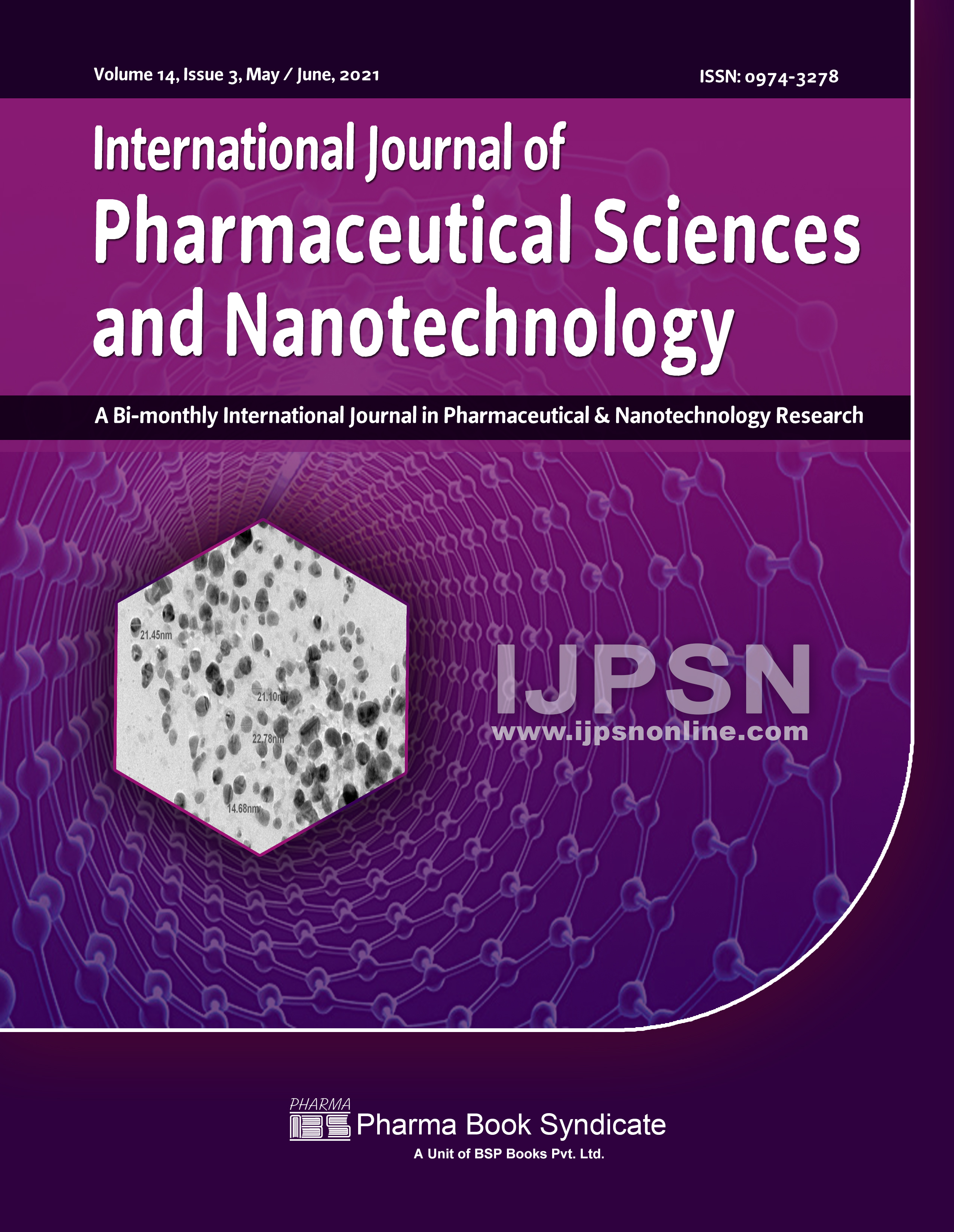Formulation and Evaluation of Ketoprofen Using β-Cyclodextrin Capped Silver Nanoparticles
DOI:
https://doi.org/10.37285/ijpsn.2021.14.3.7Abstract
The objective of the study was to develop silver nanoparticles loaded with Ketoprofen (Ag-KP) for increasing the drug solubility and thereby its bioavailability. Ag-KP were prepared by the solvent evaporation method using β-Cyclodextrin as a biodegradable polymer. Different formulations of Ag-KP were characterized for the drug entrapment efficiency, Fourier Transform Infrared Spectroscopy (FTIR), particle size analysis, X-ray diffraction studies (XRD), scanning electron microscopy (SEM) and in-vitro dissolution studies. The optimized formulation (F6) has shown an average particle size of 167.8 ± 3.46 nm,zeta potential of -23.7 ± 1.46 mV. FTIR revealed that the drug showed good excipient compatibility. XRD studies showed that the drug has changed from crystalline to amorphous state. In all formulations, F6 formulation (optimized) exhibited high drug entrapment efficiency (∼93%). SEM studies indicated the shape of Ag-KP was roughly spherical with smooth surface. In vitro dissolution studies showed that Ag-KP from F6 formulation was 94.3 ± 4.9% but for the marketed formulation, it is only 84.6 ± 3.7% in 12 hours and F6 was found to be found stable for three months at both refrigerated and room temperature (RT).
Downloads
Metrics
Keywords:
Ketoprofen, Silver Nanoparticles, β-Cyclodextrin, Zeta sizer, In-vitro dissolution studies, Stability StudiesDownloads
Published
How to Cite
Issue
Section
References
Bone AJ (2012). Biotic and abiotic interactions in aquatic microcosms determine fate and toxicity of Ag nanoparticles: part 2 – toxicity and Ag speciation. Environ Sci Technol, 46: 6925–6933.
Marambio-Jones C, Hoek EMV (2010). A review of the antibacterial effects of silver nanomaterials and potential implications for human health and the environment. J Nanoparticle Res, 12: 1531–1551.
Cleveland D (2012). Pilot estuarine mesocosm study on the environmental fate of silver nanomaterials leached from consumer products. Sci Total Environ, 421–422: 267–272.
Fabrega J et al., (2011). Silver nanoparticles: behavior and effects in the aquatic environment. Environ Int, 37: 517–531.
Hood E (2004). Nanotechnology: looking as we leap. Environ Health Perspect, 112: A740–A749.
Kantor TG (1986). Ketoprofen, A Review of Its Pharmacologic and Clinical Properties.Pharmacotherapy, 6: 93-103.
Lazareva A, Keller AA (2014). Estimating potential life cycle releases of engineered nanomaterials from wastewater treatment plants. ACS Sustain ChemEng, 2: 1656–1665.
Lin PC et al., (2014). Techniques for physicochemical characterization of nanomaterials. Biotechnol Adv, 32: 711–726.
Rai M et al., (2009). Silver nanoparticles as a new generation of antimicrobials. Biotechnol Adv, 27: 76–83.
El-Shabouri MH (2002). Positively charged nanoparticles for improving the oral bioavailability of cyclosporin-A. Int J Pharm, 249: 101–8.
Chu MQ, Gu HC (2002). Study on the preparation of tanshinoneproliposomes by spray drying method. Chin Pharm J, 37: 32–35.
Maillard JY, Hartemann P (2012). Silver as an antimicrobial: facts and gaps in knowledge. Crit Rev Microbiol, 39: 1–11.
Mehanna A (2003). NSAIDs: Chemistry and Pharmacological Actions. Am J Pharm Educ, 67(2): 63.
Matougui N (2016). Lipid-based nanoformulations for peptide delivery. Int J Pharm, 502: 80–97.
OkaiTettey-Amlalo RN (2005). In Vitro Release of Ketoprofen from Proprietary and Extemporaneously Manufactured Gels, Rhodes University, A Thesis of Master,
De Paiva REF et al., (2012). Synthesis, spectroscopic characterization, DFT studies and antibacterial assays of a novel silver(I) complex with the anti-inflammatory nimesulide, Polyhedron 36: 112–119.
Kalhapure RS, Akamanchi KG (2013). A novel biocompatible bicephalous dianionic surfactant from oleic acid for solid lipid nanoparticles, Colloids Surfaces B Biointerfaces; 105: 215–222.
Kalhapure RS et al., (2015). Solid lipid nanoparticles of clotrimazole silver complex: an efficient nano antibacterial against Staphylococcus aureus and MRSA, Colloids Surfaces B. Biointerfaces, 136: 651–658.
Ghaffari S et al., (2011) Stability and antimicrobial effect of amikacin-loaded solid lipid nanoparticles. Int J Nanomed, 6: 35–43.
Prabhu S, Poulose EK (2012). Silver nanoparticles: mechanism of antimicrobial action, synthesis, medical applications, and toxicity effects. Int. Nano Lett, 2: 32-39.
Sanjeeb KS et al., (2008). Nanotechnology in ocular drug delivery. Drug Discovery Today 13.
Kalinowska-Lis U et al., (2015). Synthesis, characterization and antimicrobial activity of water-soluble silver(i) complexes of metronidazole drug and selected counter-ions. Dalton Trans, 44: 8178–8189.
Rui Yang et al., (2008). Preparation and evaluation of ketoprofen hot-melt extruded enteric and sustained-release tablets, Drug Dev Ind Pharm, 34: 83-89.
Vinay Kumar V et al., (2007). Development and evaluation of nitrendipine loaded solid lipid nanoparticles: Influence of wax and glyceride lipids on plasma pharmacokinetics. Int J Pharm, 335: 167-175.
Zhang W et al., Influence of dissolved oxygen on aggregation kinetics of citrate-coated silver. REF.






